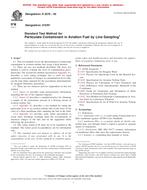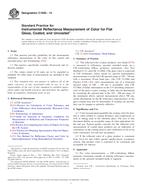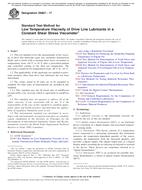1.1 This guide describes various direct push ground water monitoring wells and provides guidance on their selection and installation for obtaining representative ground water samples and monitoring water table elevations. Direct push wells are used extensively for monitoring ground water quality in unconsolidated formations. This guide also includes discussion of some groundwater sampling devices which can be permanently emplaced as monitoring wells.
1.2 This guide does not address the single event sampling of ground water using direct push water samplers as presented in Guide D 6001. The methods in this guide are often used with other tests such as direct push soil sampling (Guide D 6282) and the cone penetrometer test (Guide D 6067). The present guide does not address the installation of monitoring wells by rotary drilling methods such as those presented in Practice D 5092. Techniques for obtaining ground water samples from monitoring wells are covered in Guide D 4448.
1.3 The installation of direct push ground water monitoring wells is limited to unconsolidated soils and sediments including clays, silts, sands, and some gravels and cobbles. Penetration may be limited, or damage may occur to equipment, in certain subsurface conditions; some of which are discussed in . Information in this guide is limited to ground water monitoring in the saturated zone.
1.4 This guide does not purport to comprehensively address all of the methods and issues associated with monitoring well installation. Users should seek input from qualified professionals for the selection of proper equipment and methods that would be the most successful for their site conditions. Other methods may be available for monitoring well installation, and qualified professionals should have flexibility to exercise judgement concerning alternatives not covered in this guide. The practice described in this guide is current at the time of issue; however, new, alternative, and innovative methods may become available prior to revisions. Therefore, users should consult with manufacturers or producers prior to specifying program requirements.
1.5 This guide offers an organized collection of information or a series of options and does not recommend a specific course of action. This document cannot replace education or experience and should be used in conjunction with professional judgement. Not all aspects of this guide may be applicable in all circumstances. This ASTM standard is not intended to represent or replace the standard of care by which the adequacy of a given professional service must be judged, nor should this document be applied without consideration of a project’s many unique aspects. The word “Standard” in the title of this document means only that the document has been approved through the ASTM consensus process.
1.6 This standard does not purport to address all of the safety concerns, if any, associated with its use. It is the responsibility of the user of this standard to establish appropriate safety and health practices and determine the applicability of regulatory requirements prior to use.
Product Details
- Published:
- 07/01/2004
- Number of Pages:
- 9
- File Size:
- 1 file , 140 KB
- Redline File Size:
- 2 files , 260 KB


